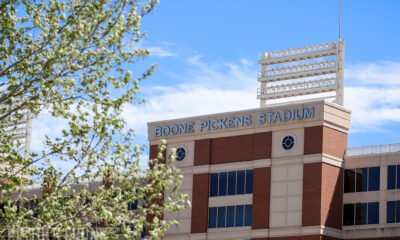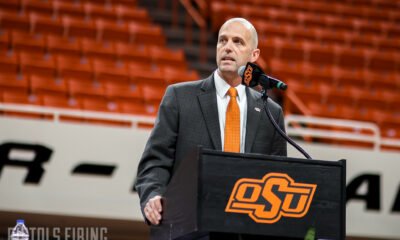Football
Where Will the Money Go If There Are No Oklahoma State Seasons?
Why OSU is taking the hit.

With Oklahoma State staring at what could be a $77 million problem this fall if football doesn’t happen, I thought it would be interesting to explore where all that money is going.
Let’s start here and use some very round numbers.
The annual Big 12 payout to Oklahoma State (and other Big 12 schools) these days is around $40 million. This year projects to be a little under that (more on this in a minute), but that’s the very broad figure OSU is working with as it pertains to conference distribution. You can read more about that here.
It’s difficult to tell how that $40 million is broken out, but it does appear that around $10 million of it (generally) is distributed based on postseason football games, which means that around $30 million is based on media rights (mostly between football and hoops). Again, these are broad numbers that don’t necessarily matter a ton for this exercise.
The point is to identify where the money is going. If for some reason the entire sports school year is wiped out, what happens to the $40 million? Note: I don’t think this is realistic at all, but I wanted to go down the rabbit hole.
Here’s how schools like OSU receive that Big 12 money.
1. ESPN and FOX pay the Big 12 a stupid amount of money for the right to broadcast its football games on Saturdays (and Thursdays and Fridays). The Big 12 pays the schools at the end of the year.
2. ESPN and FOX (and other networks) pay the Big 12 a stupid amount of money for the right to broadcast bowl games. The Big 12 pays the schools at the end of the year. I’m unclear on whether this money goes from ESPN to the Alamo Bowl (for example) and then on to the Big 12. Regardless, the Big 12 ends up with it.
So how does ESPN make the money to pay the Big 12 to begin with? Well, two primary ways. The first is that they sell the crap out of their commercial breaks during football games to the BMWs and Rolexes of the world. The second is from us, the cable subscriber (or YouTube TV subscriber).
Here’s how Awful Announcing puts it.
ESPN and other sports networks negotiate certain carriage fees with all cable and satellite companies. Sports channels dominate the list of priciest channels, with the average cable customer paying nearly $20 for sports channels, regardless of whether or not they watch any sports. About half of these fees go to ESPN, which includes ESPN, ESPN2, ESPNU, and potentially the likes of ESPN Classic, ACC Network, and SEC Network. [Awful Announcing]
Again, all of this is pretty straightforward if you simply sit down and think it through. You — OSU fan — are paying OSU to watch OSU games even if that money first goes to DirecTV and then to ESPN and then to the Big 12 and then to OSU.
But with no games, ESPN (and others) aren’t going to be paying the Big 12 (or anyone else). Or at least that’s the initial indication based on what happened during March Madness.
One bellwether for the impending industry stand-off is March Madness, the National Collegiate Athletic Association’s annual basketball tournament, which was completely canceled. The NCAA’s contract with network providers ViacomCBS and WarnerMedia differs from those of professional sports leagues, according to people familiar with the matter, allowing the programmers to save some of the money they’d initially agreed to pay for the right to broadcast tournament games.
“CBS is not going to pay for this season and have no financial recourse at all,” Pilson said. “The networks are not paying for games that aren’t delivered. They may have a formula where certain monies change hands and eventually they’ll get credit for that.”
That has ramifications up and down the supply chain. The NCAA received less money than normal from its broadcast and cable partners, which means individual colleges will also get less TV money than typical for 2020. Distributors will also pay diminished fees for regional sports networks, such as the SEC network or the Big 10 network, which aired fewer games than contracts specified. [CNBC]
The March Madness news is why Big 12 commissioner Bob Bowlsby recently noted that there will be a $15-$18 million shortfall in conference revenue and one reason schools such as Iowa State and Kansas are asking their coaches to take a paycut. They aren’t getting the money they were supposed to from the Big 12 because the Big 12 was not paid by the networks because there were no games because of the coronavirus.
There’s a twist though.
Your cable bill hasn’t stopped coming, right? Which means that ESPN is having its cake and eating it, too (alongside other content providers). Even though advertising revenue has dropped precipitously, ESPN is still getting fees from places like DirecTV and Comcast because you’re still paying that money on your cable bill. The difference is that it isn’t getting passed on to the Big 12 and eventually to OSU.
Some people have a big problem with this.
If you have basic cable, should you have to pay for ESPN, FS1 or any other sports-related channel during a period where there are no, or very few, live sports being broadcast?
Letitia James doesn’t think so. She happens to be the attorney general of New York, and this week, she sent a letter to the nation’s cable providers requesting that they “promptly and voluntarily provide relief to affected New York consumers from continued high cable television charges.” [Yahoo]
This is all very illuminating on how players (professionally) are paid and how schools (collegiately) make money, but none of it changes the fact that a highway from your checking account to OSU with exit ramps at DirecTV, ESPN and the Big 12 has been disrupted. The pandemic is removing the Big 12 and OSU from that equation so that ESPN and DirecTV are the only companies making money.
That’s unsustainable in the long term of course, but it does make me wonder if any of this will change down the road. It’s not outrageous to think the pandemic could disrupt the next round of negotiations between content providers and the Big 12 later in the mid-20s.
In the short term, I suspect football will resume at some point later in 2020, which means all the power players in the above equation will get paid. If there’s another hiccup, though, or even a future cancelation, you can see the disastrous consequences for the Big 12 and for OSU. ESPN has its own advertising-related issues, but for now it seems they (and other networks) will skate along without having to worry too much about the short-term because of the position they hold. If games are played, they pay. If they’re not, they don’t. Either way, they’ll likely continue to rake in subscriber revenue.
Hopefully all of this is moot come September and October as football gets underway (?), but it’s certainly been a bit of a pull-back-the-curtain moment for consumers and the companies who produce the products they consume on television and elsewhere in the sports media world.

-

 Football5 days ago
Football5 days agoFour-Star Wide Receiver Jaden Perez Commits to Oklahoma State
-

 Wrestling4 days ago
Wrestling4 days agoOSU Wrestling: Olympic Chances End for Cowboy Hopefuls
-

 Football2 days ago
Football2 days agoFour-Star Quarterback Adam Schobel Commits to Oklahoma State, Flips from Baylor
-

 Hoops2 days ago
Hoops2 days ago‘Keep Turning Over the Rocks’: Looking at the Portal Landscape as Lutz Looks to Solidify His First OSU Roster






